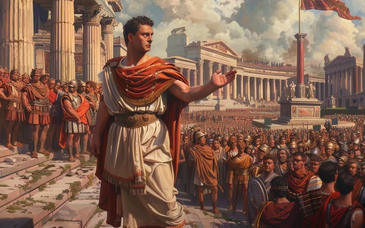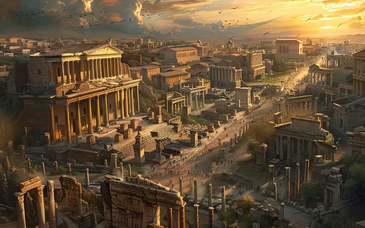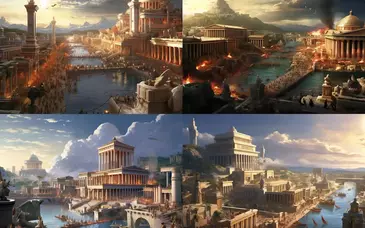The Second Punic War, like the first falls into distinct stages. The Roman plan of attack was to invade Africa at once with the first army, and at least disorganize Carthaginian mobilization. The second army was sent to Massilia, in Hannibal should interfere with friends of Rome north of the Ebro. A third force was obviously required to garrison the Gaulish territories between the Apennines and the Po, which had only surrendered three years before, and were known to have been visited by agents of Hannibal, and to have promised him free passage if he should try to reach Italy by land.
Some of the Gauls indeed revolted at once, and delayed the departure of the northern force to Massilia, till it was too late to stop Hannibal even at the Rhône, For this was his master stroke, to circumvent both Roman sea power and Rome's Greek allies between Ebro and Alps, and establish an enemy base in the heart of the Roman dominion. He certainly counted on such measure of support from his friends in Carthage as would deplete the Roman garrisons in Italy for the defence of Sicily and the south. With good fortune the Roman first army might be shut up in Africa, and destroyed there like that of Regulus.
Hannibal crosses the Alps
But the Roman army commanders reacted to Hannibal's strategy as best they could. The southern army was diverted, just as it was sailing for Africa, and brought round by sea to the Adriatic flank of the northern front, where the new military road gave it direct reinforcement from Rome. Consequently when Hannibal after unprecedented hardships descended on the Italian side of the Alps, he found a Roman field army strongly posted under shelter of the new garrison colonies on the Po.
More happily still for Rome, the force that was too late to intercept Hannibal at Massilia was led at once into Spain, to disorganize his only sure source of reinforcements and undo the empire-building of his father and himself.
Hannibal's tactics and leadership, however, were as brilliant as his strategy. His first Italian campaign in 218 BC broke Roman resistance north of the Apennines at the fords of Trebia and Ticinus. His next destroyed their whole army at Lake Trasimene in Etruria, and seemed to open a straight road to Rome. But the third year found him not at the gates of Rome, but far to the southward, now in Apulia, now in Campania. And even the victory in which he destroyed yet another whole army at Cannae (216 BC) brought him no nearer to his goal than when he abandoned Etruria.
Battle of Cannae
There were several reasons for this. A flying column such as his necessarily consisted of cavalry, and for horse pasture Italy has no large plains except for the far south. The greater corn-lands also are all remote from Rome. No nearer indeed than Campania. Therefore, if Rome itself did not fall at the first assault, it was necessary to find some such Italian base, and await reinforcements from Carthage or Spain.
As long as the Roman colonies in the area stood, the countryside dared not rise even if it wished to do so. And it was the worst disillusionment of Hannibal, that the peoples of Italy, and even what was left of the Etruscans, gave almost no sign of disaffection with Rome. Hannibal could remember the 'Truceless War' between Carthage and her mercenaries, and the African campaign of Regulus was only ten years before his birth.
But this was quite another situation. The subjects of Carthage had been ready enough to make common cause with her enemies, but Rome's bold experiment of clemency after surrender, and progressive incorporation in her own commonwealth had succeeded too completely for any cessation to take place.
Hannibal's first stroke than had failed. But he had established himself in southern Italy, where Pyrrhus had fought, and he had secured possession of Campania. It was another thirteen years before he left Italy by his own choice. He had, however, no seaport, and, what was worse, no assurance of help from Carthage, which seems to have taken little further part in the war, except for a raid on Sardinia in 215 BC, when it ought to have been sending men to Hannibal, and the landing of a small force in southern Italy in the following year.
Capture of Syracuse
Two strokes of ill luck, however, befell the Romans in this middle period of the war. Hiero of Syracuse died in 216 BC, a very old man. Herio's grandson Hieronymus acceded to the throne and sided with Carthaginians. But ancient Syracusan feuds soon saw Hieronymus murdered. The popular party seized the chance to revive old dreams of a Syracusan empire. These were encouraged by Hannibal, and also by the Carthaginian government, which profited by the Sicilian revolt to reoccupy a large part of the island. Rome therefore sent forth a Roman expedition under the command of Claudius Marcellus who laid siege to Syracuse by land and sea. But under Hiero Syracuse had been enormously fortified, and equipped with powerful catapults and all kinds of fantastical war machinery devised by the genius Archimedes, who lived in Syracuse. By these devices no direct assault was possible, leaving no other options to the Romans but to blockade the city as best they could. Alas, in 212 BC, Marcellus in a surprise night attack managed to capture the outer defences of Syracuse, though it took until 211 BC before a traitor inside the city opened a gate to enable the capture of Syracuse. The death of Archimedes, one of the greatest geniuses of mankind, It is hence attributed to Marcellus' capture of Syracuse, where the great thinker was slain amongst the turmoil that befell the city as it was stormed by Roman legionaries. With the capture of Syracuse Hiero's hoarded riches were made available for the conduct of the war. Even so, Carthaginian forces were not completely expelled from the province until 210 BC.
Philip V of Macedon allies with Hannibal
The other misfortune was the dislike of Rome by Philip V of Macedon (which had arisen with Rome's earlier involvement in Illyria), and the help consequently rendered by him to Hannibal from oversea, until the Romans stationed a strong squadron war ships in the Adriatic and later managed to capture Hannibal's Adriatic ports. Meanwhile Philip's attention was distracted by encouraging a coalition of Greek cities against him. Not only did this make Macedonia a useless ally to Carthage in the Punic War, but it also further confirmed Rome as the protector of the Greek cities agianst the Macedonians.
Hannibal's situation in Italy became steadily worse. Capua, which had fallen into his hands after his victory at Cannae was besieged in 212 BC by the Roman army and destroyed utterly in the following year for its treachery to Rome. Tarentum, which deserted to Hannibal in 212 BC and should have been invaluable, had Carthage used this direct means of communication to send him reinforcements, was retaken in 209 BC. And the long-expected rising in Etruria and in a few Latin towns, when they did at last take place, were half-hearted, and easily suppressed. The 'Fabian tactics' adopted by Q. Fabius Cunctator, of remaining on the defensive against Hannibal and refusing battle, had now been mastered by the Romans and gave the enemy little chance to gain spectacular successes like those of the first three campaigns. The whole country was sick of the war. The invader had outstayed his welcome, and a veteran army ages rapidly without reinforcements. Hannibal had left in Spain his brother Hasdrubal, with instructions to follow with another flying column like the first.
But the strategy of the Scipios, who had occupied first Massilia and then Tarraco near the mouth of the Ebro, in the first year of the war, made this plan impossible.
Their occupation of Tarraco was a counter-stroke to the Carthaginian 'New Carthage', and their personal qualities and diplomatic skill shook the allegiance of native leaders in Spain, and even in Numidia. There was a reaction, however, about 212 BC, for the Spanish tribes found that they had only made a change of masters, and attempted to free themselves from the new ones. But the young and brilliant Publius Cornelius Scipio succeeded in 210 BC (or 209 BC) in capturing 'New Carthage' in a surprise attack, and with it much treasure, a fleet and, best of all, Hasdrubal's Spanish hostages.
By this time, however, Hasdrubal was ready. He slipped past Scipio's forces, spent the winter of 208 BC quietly in the central highlands of Gaul, and entered Italy unopposed in 207 BC. Only the skillful co-operation of the two consular armies prevented his junction with Hannibal, which seemed inevitable. Leaving in the south only a portion of his army, which effectively masked his movement, C. Claudius Nero raced north with a picked force, joined his colleague Livius, surprised, defeated and killed Hasdrubal at the Metaurus river, east of the Apennines, and was back in the south before Hannibal discovered that only a skeleton force had been facing him. The battle of the Metaurus destroyed Hannibal's last hope of receiving reinforcements.
Meanwhile Scipio had expelled the remaining Carthaginians from Spain, defeated their counter-attack in 206 BC, and persuaded Masinissa, a leading chief of the Numidians, to exchange the Carthaginian for a Roman alliance. Having returned to Rome, he was then allowed to raise a fresh army largely composed of Italian volunteers, for a blow at the heart of the Carthaginian rule in Africa. Here, his old friendship with Masinissa enable him to distract and eventually capture Syphax, the chief Numidian ally of the Carthaginians, and cut off the source of their supply of cavalry. Hannibal was paralyzed. Rome had been relieved of the Macedonian complication in 205 BC and was able now to concentrate upon the war in Africa.
Hannibal's last stand at Zama
Battle of Zama
By 202 BC the condition of the Carthaginian home territory was desperate. Hannibal, and his other brother, Mago, who had escaped from Spain and landed on the coast of Italy, were recalled to defend Carthage itself, and attempts were made to obtain peace before the situation became more serious. But Scipio and Masinissa, each for his own reasons, persisted. They defeated the last field army that Carthage could rake together at Zama, and were able to impose their own terms.
Carthage formally surrendered Spain, and all other dependencies outside the home district of Africa. Even within the narrow limits, no war was to be declared without Roman permission. All ships but ten were surrendered, all elephants, and prisoners of war. And the enormous indemnity that was imposed - ten thousand talents spread over fifty years - made the Carthaginians practically tributaries to their Roman conquerors. Masinissa received the whole of Numidia and Roman citizenship, as the 'friend and ally' of the Roman people, so that he could invoke Roman intervention in Africa, whenever it was convenient.
Hannibal was allowed to remain in Carthage, and did what he could to restore public confidence and credit. But his old political enemies were too strong for him, and in 190 BC he was banished, and spent the rest of his life at the courts of Greek kings in Syria and in Asia Minor.
With the Second Punic War at an end Rome stood as a new confident power, free of direct threats to herself. The Roman army had just shattered the Carthaginians and was no doubt larger than the government had ever intended it to be. At this point, free from the burden of the Carthaginian menace, Rome was a power of great potential.



